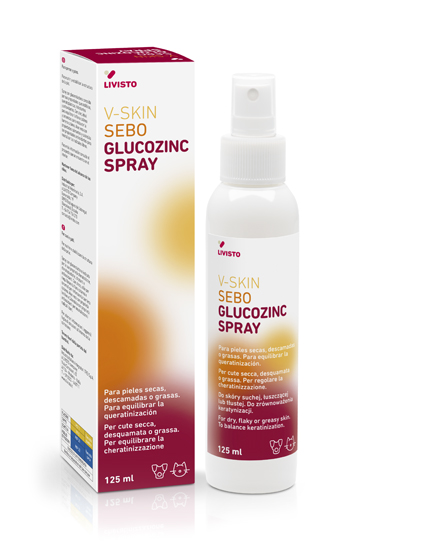CUTE SECCA, DESQUAMATA O
GRASSA DI CANI E GATTI
CUTE SECCA, DESQUAMATA O GRASSA DI CANI E GATTI
V-SKIN
SEBO
GLUCOZINC SPRAY
Per cute secca, desquamata o grassa di cani e gatti. GlucoZinc spray contribuisce a nutrire e stabilizzare la barriera cutanea.
Caratteristiche del prodotto
- Contiene gluconolattone, un componente ad azione cheratolitiche per l’esfoliazione e la riduzione della desquamazione.1, 2, 3, 4, 5
- Contiene Calendula e Aloe Vera con proprietà antinfiammatorie e lenitive .7, 8, 9, 10, 11, 12, 13, 14, 15, 16, 17
- Con Zinco con proprietà antibatteriche e antimicotiche.6
- Contiene ceramidi per ripristinare l’epitelio, mantenere la funzione barriera e idratare la pelle.18, 19, 20
Quando utilizzarlo:
- Spray adatto per aree di difficile accesso, come gli spazi interdigitali..
Come utilizzarlo:
- Spruzzare sulle zone desiderate.
- Non necessita di risciacquo.
- Può essere utilizzato quotidianamente. In alcuni casi, potrebbe essere consigliabile tagliare il pelo per facilitare il contatto del prodotto con la cute
Guarda il video dell'applicazione del prodotto!
Opinioni dei veterinari
I used SEBOGLUCOZINC SPRAY for a female dog with extreme flaky, greasy skin. After several actions, including spray use and dietary changes, the condition improved quickly.

Absorbs quickly, while the skin's moisturising effect is visible - clearly rebuilds the skin's hydrolipidic layer.

Bibliografia
- Berardesca E, Distante F, Vignoli GP, Oresajo C, Green B. Alpha hydroxyacids modulate stratum corneum barrier function. Br J Dermatol 1997;137:934-938.
- Hachem JP, Roelandt T, Schürer N, Pu X, Fluhr J, Giddelo C, Man M-Q, Crumrine D, Roseeuw D, Feingold KR, Mauro T, Elias PM. Acute acidification of stratum corneum membrane domains using polyhydroxyl acids improves lipid processing and inhibits degradation of corneodesmosomes. J Invest Dermatol. 2010;130:500-10.
- Bernstein EF, Brown DB, Schwartz MD, Kaidbey K, Ksenzenko SM. The polyhydroxy acid gluconolactone protects against ultraviolet radiation in an in vitro model of cutaneous photoaging. Dermatol Surg. 2004;30:189-196.
- Puigdemont A, Furiani N, De Lucia M, Carrasco I, Ordeix L, Fondevila D, Ramió-Lluch L, Brazis P. Topical polyhydroxy acid treatment for autosomal recessive congenital ichthyosis in the golden retriever: a prospective pilot study. Vet Dermatol. 2018; 29: 323-e113. May 22. doi: 10.1111/vde.12654
- Jarząbek-Perz, S., Mucha, P.; Rotsztejn, H. (2021). Corneometric evaluation of skin moisture after application of 10% and 30% gluconolactone. Skin Research and Technology, (5), 925–930.
https://doi.org/10.1111/srt.13044 - Abendrot, M., & Kalinowska-Lis, U. (2018). Zinc-containing compounds for personal care applications. In International Journal of Cosmetic Science (Vol. 40, Issue 4, pp. 319–327). Blackwell Publishing Ltd.
https://doi.org/10.1111/ics.12463 - Hekmatpou, D., Mehrabi, F., Rahzani, K., & Aminiyan, A. (2019). The effect of aloe vera clinical trials on prevention and healing of skin wound: A systematic review. In Iranian Journal of Medical Sciences (Vol. 44, Issue 1).
- Sánchez, M., González-Burgos, E., Iglesias, I., & Gómez-Serranillos, M. P. (2020). Pharmacological update properties of aloe vera and its major active constituents. In Molecules (Vol. 25, Issue 6).
https://doi.org/10.3390/molecules25061324 - Teplicki, E., Ma, Q., Castillo, D. E., Zarei, M., Hustad, A. P., Chen, J., & Li, J. (2018). The effects of aloe vera on wound healing in cell proliferation, migration, and viability. Wounds, 30(9).
- Kamr, A., Arbaga, A., El-Bahrawy, A., Elsify, A., Khaled, H., & Hassan, H. (2020). The therapeutic efficacy of Aloe vera gel ointment on staphylococcal pyoderma in dogs. Veterinary World, 13(11).
https://doi.org/10.14202/VETWORLD.2020.2371-2380 - Arbaga, A., El-Bahrawy, A., Elsify, A., Khaled, H., Hassan, H. Y., & Kamr, A. (2021). Biochemical and histopathological changes related to the topical application of Aloe vera ointment for canine pyoderma. Veterinary World, 14(5).
https://doi.org/10.14202/vetworld.2021.1354-1362 - Preethia, K. C., Kuttanb, G; Kuttan, R. (2009). Anti-inflammatory activity of flower extract of Calendula officinalis Linn. and its possible mechanism of action. Indian Journal of Experimental Biology 2009 47(2)
- Tresch, M., Mevissen, M., Ayrle, H., Melzig, M., Roosje, P.; Walkenhorst, M. (2019). Medicinal plants as therapeutic options for topical treatment in canine dermatology? A systematic review. BMC Veterinary Researc, (1).
https://doi.org/10.1186/s12917-019-1854-4 - Giostri, G. S., Novak, E. M.; Guarita-Souza, L. C. (2021). Treatment of acute wounds in hand with Calendula officinalis L.: A randomized trial. Tissue Barriers.
https://doi.org/10.1080/21688370.2021.1994822 - Cruceriu, D., Balacescu, O; Rakosy, E. (2018). Calendula officinalis: Potential Roles in Cancer Treatment and Palliative Care. In Integrative Cancer Therapies (Vol. 16, Issue 4, pp. 1068–1078). SAGE Publications Inc.
https://doi.org/10.1177/1534735418803766 - Lima, M. dos R., Lopes, A. P., Martins, C., Brito, G. A. C., Carneiro, V. C; Goes, P. (2017). The effect of Calendula officinalis on oxidative stress and bone loss in experimental periodontitis. Frontiers in Physiology, (JUN).
https://doi.org/10.3389/fphys.2017.00440 - John, R.; Jan, N. (2017). Calendula Officinalis-An Important Medicinal Plant with Potential Biological Properties.Proceedings of the Indian National Science Academy,(0).
https://doi.org/10.16943/ptinsa/2017/49126 - ung, J. Y., Nam, E. H., Park, S. H., Han, S. H.; Hwang, C. Y. (2013). Clinical use of a ceramide-based moisturizer for treating dogs with atopic dermatitis. Journal of Veterinary Science, 14(2), 199–205.
https://doi.org/10.4142/jvs.2013.14.2.199 - Reiter, L. v., Torres, S. M. F.; Wertz, P. W. (2009). Characterization and quantification of ceramides in the nonlesional skin of canine patients with atopic dermatitis compared with controls. Veterinary Dermatology, 20(4), 260–266.
https://doi.org/10.1111/j.1365-3164.2009.00759.x. - Yoon, J. S., Nishifuji, K., Ishioroshi, S., Ide, K.; Iwasaki, T. (2013). Skin lipid profiling in normal and seborrhoeic shih tzu dogs. Veterinary Dermatology, 24(1).
https://doi.org/10.1111/j.1365-3164.2012.01102.x.



 Sul nostro sito web utilizziamo i cookie per offrirvi l'esperienza più pertinente possibile, ricordando le vostre preferenze e le vostre visite ripetute. Facendo clic su “Accetta”, si acconsente all'utilizzo di TUTTI i cookie. Tuttavia, è possibile visitare le Impostazioni dei cookie per fornire un consenso controllato.
Sul nostro sito web utilizziamo i cookie per offrirvi l'esperienza più pertinente possibile, ricordando le vostre preferenze e le vostre visite ripetute. Facendo clic su “Accetta”, si acconsente all'utilizzo di TUTTI i cookie. Tuttavia, è possibile visitare le Impostazioni dei cookie per fornire un consenso controllato.